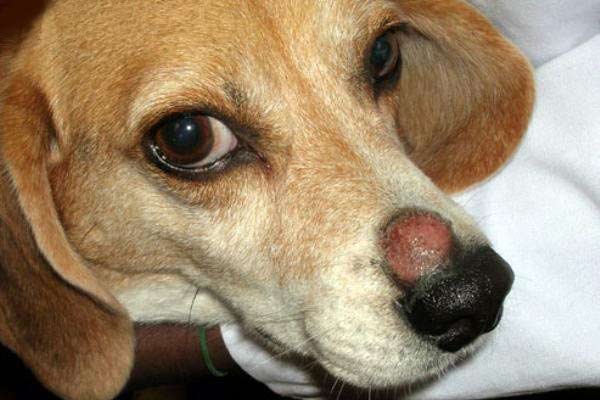Eczema in dogs is an inflammatory process in the skin of an animal. The disease is common and is caused by various pathogenetic factors. Timely diagnosis and treatment hampered by the fact that the skin of the animal is covered with wool that hides the beginning of changes in the skin.
Content
- 1. What is eczema in dogs
- 2. Causes of the disease
- 3. Symptoms and manifestations of pathology
- 4. Methods for diagnosing the disease
- 5. Therapy of eczema in dogs
What is eczema in dogs
Contents
Eczema is a non-infectious inflammatory disease of the skin dogs, which can begin acutely and become chronic recurrent form. 
In view of the pathological process, eczema in dogs can be weeping and dry. Both types of disease differ not only in the nature of external manifestations, but also for a number of signs – localization lesions, the form of the pathological process, age-related demorphism.
Wet eczema is characterized by the appearance on the dog’s skin open wound surfaces. In the initial stage, as a result the influence of various factors, a focus of inflammation of the upper epidermis layer – irritation, redness. Then appear vesicles with serous discharge. Papules, opening, form open wounds. Subsequently, pathogenic microflora, causing secondary infection.
Dry eczema is manifested by the formation of exfoliating plates keratinized epidermis devoid of hair. Often this kind of eczema characteristic of the chronic course of pathology. Acute course diseases can be accompanied by febrile events.
In chronic eczema, a change in the condition of the skin occurs. She thickens, becomes loose. The lesions are localized in nooks (under ears, in folds) or areas of increased mechanical impact (back, sides, tail, neck). In age animal risk of disease increases. Increased skin folding and copious undercoat also provokes eczema. Often eczema in chronic form is localized in the back, head, on the face, paws.
Read: How to give a dog a pill.
Causes of the disease
The appearance of eczema is affected by various internal and external factors:
- injuries (rubbing with a muzzle, a collar, scratching in places insect bites, effects of extreme temperatures);
- a high degree of infection with parasites (fleas, ticks, lice);
- poor hygiene (dirt, dust, high humidity in the skin folds, irritating effect of saliva, tears);
- chemical exposure (unsuitable detergents, kerosene, gasoline, etc.);
- parasitic and infectious diseases;
- systemic diseases;
- metabolic disorders, vitamin deficiency;
- autonomic disorders;
- malnutrition;
- obesity;
- stress
- genetic predisposition due to breed and other
Depending on the stage and type of eczema, manifestations vary pathology.
Symptoms and manifestations of pathology
For eczema in dogs, it is characteristic that in one area of the lesion various stages of the process can be observed. With weeping eczema in dogs noted:
- severe itching;
- pain
- increase in temperature indicators of the body;
- chills;
- apathy and passivity;
- refusal of food;
- digestive upset and bowel movements;
- strong weight loss;
- nervousness, sleep disturbance.
Externally, the pathology is manifested in local hair loss, the formation of wounds with the expiration of the sucrose, which glues the wool. Separate foci of inflammation merge, forming vast areas. Dry eczema is usually accompanied by significant itching. in the absence of pain. In places where dry areas of the epidermis, the hair thins, and then completely falls out.
Diagnosis methods
Some manifestations and symptoms are characteristic in general for many dermatoses, for example scabies, demodicosis, trichophytosis, etc. Therefore to clarify the diagnosis, differential studies are carried out:
- dog blood test;
- microscopic and bacterial examination of scraping;
- inspection of wool for eggs, larvae and adult bloodsucking insects.
When establishing the internal causes of the disease, additional examination methods required:
- radiography;
- Ultrasound
After confirmation of the preliminary diagnosis and clarification Causes of pathology An individual treatment regimen is being developed.
- treatment of dermatitis in dogs;
- symptoms and treatment of lichen in dogs.
Therapy of eczema in dogs
Treatment is carried out conservatively and comprehensively. IN First of all, annoying factors are eliminated:
- the dog is washed with special pH neutral shampoos;
- in the presence of skin parasites, sanitation is performed;
- exclude direct contact with the sun, high temperature or cold;
- eliminate the effects of chemicals and mechanical irritation.
Be sure to review the diet and diet – introduce products containing essential amino acids – cysteine and methionine, as well as trace elements (zinc, cobalt, sulfur). In addition to products, rich in minerals and vitamins, appropriate vitamin and mineral complexes. 
With weeping eczema with copious excretion of serous fluid appoint infusion of calcium chloride, bromide sodium or sodium hyposulfite. Weakened anemic animals may prescribe a blood transfusion and drugs to increase immunity. To suppress desensitization processes, they are administered ascorbic acid solution, to enhance regeneration and processes epidermis recovery – retinol preparations.
To reduce the severity of pain, apply painkillers, novocaine blockade. If the area lesions localized on the head or neck, then novocaine injections lead on the side where the foci are located in the area located next to the spine from 2-3 cervical to 3-4 thoracic vertebra. Before the procedure, the skin is shaved, treated antiseptic. Injection is staggered okay.
With severe itching and an allergic reaction, the dog is prescribed drugs Diphenhydramine, Suprastin, Aminazine, etc. If eczema subacute and chronic course, then radiation may be prescribed ultralight x-rays. Locally foci of eczema are cleared with using special sterile wipes. Crusts soak with using chlorhexidine. Topically applied ointments – Zinc, Xeromorphic, Ichthyol or ASD-3, Resorcinol.
For the treatment of eczema, use Dermozolone, Lorinden, Fluorocort, Dermatol, corticomycin, etc. With eczema, rapid “addictive” to a particular drug, so the doctor must develop a pattern of drug alternation.
Interesting: urolithiasis in dogs.
With wet eczema, you need to use cold applications from solutions of rivanol, lead water, alum, tannin, etc. They have a drying, tanning and antimicrobial effect on dog skin. Dressings, the fabric of which is impregnated, are also used. anti-inflammatory ointments – Sinalar, Lorinden, Dermozolon.
Treat the skin around the weeping area and the area itself can solutions of Malachitegruen or Brilliantgrune. With dry eczema on the outbreak impose napkins impregnated with ASD + castor oil. Them bandage and change twice a day. In the chronic stage castor oil is replaced with fish oil.
After the process of inflammation is stopped for resorption skin seals can be applied Ichthyol ointment, Naftalan, ointment Vishnevsky, Wilkinson’s ointment. In areas with thinner and more delicate skin apply spermaceti cream, Lassar paste. Zones of persistent stagnation can be eliminated with paraffin baths.
After consulting with a veterinarian, you can apply decoctions of herbs and ointment from medicinal plants. Eczema can be applied ointment from celandine, a series of burdock, beekeeping products, juice freshly pressed leaves of plantain, etc.
Proper regular pet care, adequate treatment and following all the recommendations of a veterinarian will speed up recovery pet, and eliminate the risk of eczema return in the future.






